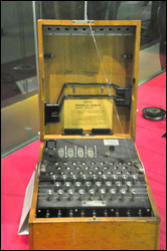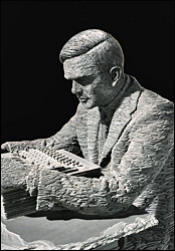

Registered Charity Number 1044195
All content copyright © Bexley u3a and others
VISIT TO BLETCHLEY PARK
4 APRIL 2014










Bexley u3a



Hall Place
A group of Bexley u3a members are currently working on a Shared Learning
Project (SLP) at Hall Place under the guidance of Priscilla Macpherson (SLP
Coordinator) and Kirsty Macklen (Bexley Heritage Trust Collections
Manager). The aim of the project is to gather material for a new exhibition
about the 200 GIs from U.S. Army 6811 Signal Security Detachment who
were stationed at Hall Place from 1943 to 1945.
The GIs were working as wireless intercept operators, listening to German
messages transmitted by radio. These intercepted messages from the
Bexley operators were sent to Bletchley Park where they were collected
together with messages from the whole network of 'Y' stations and analysed
to incorporate into the ULTRA information which has been credited by some
sources as shortening WWII by as much as two years. At the very least
ULTRA saved thousands of lives.
The Bexley SLP group decided to visit Bletchley Park to gain a deeper
understanding of ULTRA and the Bletchley Park 'Y' station network. The visit
was organised by Terry Moseley and a group of 10 of us (some project
members, together with family and friends) met at Euston and went by train
to Bletchley. As we were travelling by train, we were able to take advantage
of a 2 for 1 offer to get into Bletchley Park at a good price.
We did some general exploration of the site in small groups and then met up
at the Chauffeurs' Hut for a brief introduction and a 1-hour guided tour led
by a very knowledgeable guide, Joel Greenberg. Joel has recently written a
book entitled Gordon Welchman: Bletchley Park's Architect of Ultra. So, we
were in good hands with Joel who started his tour by telling us how the
Bletchley Park estate was initially rented in 1938 and then subsequently
purchased by the government who wanted to move the Government Code
and Cypher School out of its central London headquarters.
It was astonishing to realise that the codebreakers' wooden huts and later
brick buildings all had to be built very rapidly as the growth in the number
of staff was meteoric. No-one is exactly sure how many people worked at
Bletchley Park over the war years, but it is estimated that in 1944, at the
peak of activity, there were about 10,000 people working in Bletchley Park
and the associated out-stations. There was hardly any billeting onsite, so
the staff were billeted for many miles around in varying degrees of comfort
from rooms with local families within walking or cycling distance, to
Woburn Abbey which provided accommodation for hundreds of Wrens who
were bussed in to their work each day.
We all found Bletchley Park to be a fascinating place and in one day we only
really touched the tip of the iceberg, as the grounds are extensive with
various themes in many different buildings. Our entry tickets are valid for a
whole year, so many of the group are planning to make a return visit later
this year to visit the restored wooden huts when they are reopened with
new exhibits and all the sights, sounds and smells of that early
codebreaking era.
For more information, you may be interested in these websites:






Arrival
The Mansion
Slate statue of Alan Turing
Enigma
Hut 1
Alan Turing's Office, Hut 8
